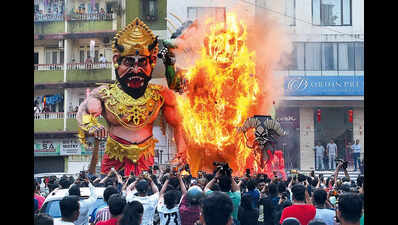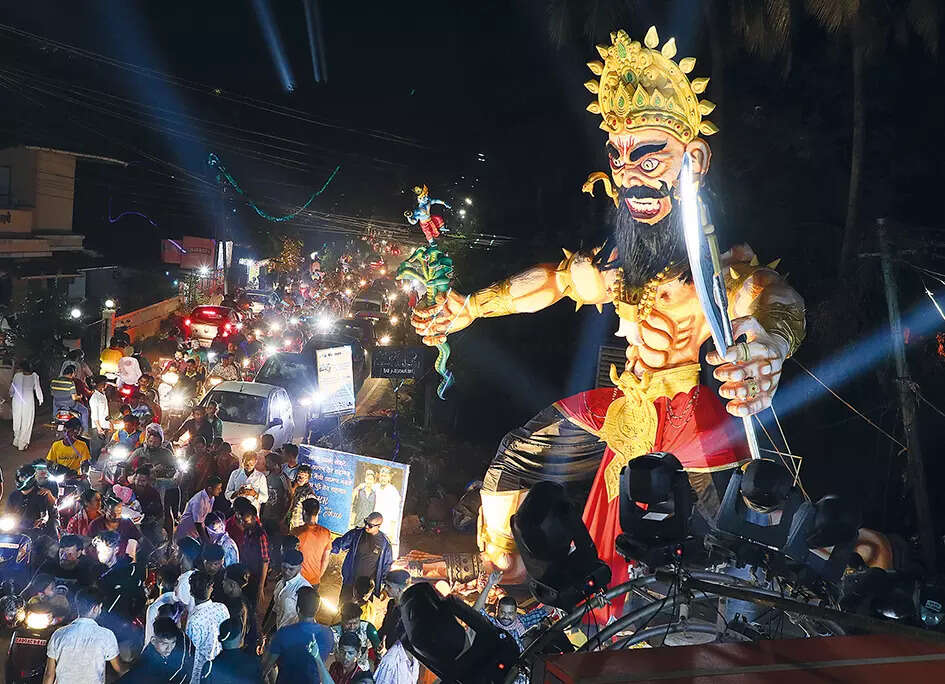ARTICLE AD BOX

Life-size and life-like Narkasur effigies currently dot the length and breadth of Goa as groups of enthusiastic youngsters converge to showcase their artistic flair. However, what started out as a form of religious expression that most people looked forward to has now transformed into an over-the-top spectacle that many dread, reports Ramit Mehrotra

As the Hindu month of Karthika arrives, there’s a palpable shift in the air — an almost magnetic pull towards festivity. Tales of courage, triumph, and the eternal battle of good versus evil resonate through the local tradition, Narkasur Vadh, wherein effigies are burnt a day before Diwali, a ritual incomparable to that of any other state.The name Narkasur is a compound of two Sanskrit words — ‘naraka’ meaning hell, and ‘asura’ meaning demon. His mythological story paints him as a tyrant who brought terror to gods and mortals alike until he was defeated by Lord Krishna. The name itself evokes fear and dread, which is intentionally reflected in the monstrous appearance of the effigies created in his image.These figures are no scarecrows. Crafted to appear fearsome, they feature exaggerated muscles, grimacing faces and monstrous designs.
Their construction is a labour of skill requiring weeks of preparation by youngsters who carry the legacy through generations.

Religious expressionThe ritual carries a meaning and a symbolic message, but doesn’t trace long roots of historical practice. According to artist and art commentator,Naguesh Rao Sardessai, it started in the state during the pre-Liberation era.“It is quite difficult to say when it really began. During the pre-Liberation era, there were restrictions in expressing one’s religiosity, so Narkasur Vadh was celebrated in smaller wards with smaller effigies.
The ritual picked up in the post-Liberation era on a small scale in a few villages. Uttar Pradesh has Ravana, Goa has Narkasur, so the people found their own symbol of overcoming evil,” he said.Gradually, according to Sardessai, other villages also started joining suit and the tradition began gaining prominence. It was commercialised by the 1990s at the behest of politicians and businesspeople. “By then, the ritual was seen as a commercial avenue to attract people.
Flush with money, businesspeople and industrialists started sponsoring art groups. Politicians also join in for political interests.
Even then, Panaji had just two to three effigies. By the 2000s, celebrations picked up and entrepreneurs began organising effigy competitions by declaring attractive cash prizes. This inspired people to scale up effigy-making not only in size but also in context. Many times, they would be used as a medium for socio-political messages,” he said.

Painstaking preparationPrakash Gupta, a 22-year-old restaurant owner from Taleigao and an active member of the ‘Prince of Bhatlem’ group that comes together annually for the project, said they start effigy preparations during Navratri.Most art groups use papier mache , coconut coir, thermocol sheets, metal wires and thin rods to construct their effigies layer by layer — the torso, the arms and the legs. The face is sculpted with clay and later coated with a ceramic paint and acrylics to be attached later to the body.
The individual parts are pieced together with homemade glue called ‘gond’ (made of maida and milk), and adorned with imitation jewellery and a crown, all made of paper craft.

“This is the one day in the year when we get to enjoy ourselves. We spend 10-12 hours making this effigy, come rain or shine, for a month, and have been doing this since childhood. We put so much of our efforts into making this effigy which many people from across the city come to see,” said Gupta.Brijesh Khandeparkar, a member of another group, said the estimated cost of creating an effigy goes up to Rs 1 lakh. Funds are generated either through contributions from members within the art group, or through donations from people in the neighbourhood.“Making the papier mache components takes time and resources, and the cost escalates accordingly too. We add our own interpretation and nuance to the effigy based on mythology,” Khandeparkar said.The art groups said Narkasur Vadh is a day of huge significance for them as it is a culmination of the month-long efforts and countless errors that result in the creation of a breathtaking spectacle. Energetic dancing and thumping music only add to the vibe, they said.According to the art groups, effigy-making in Goa has gotten socompetitive that hydraulic parts and electronic equipment are also used to incorporate human-like movements. These effigies stand at heights of 35-40mand the costs of making them skyrocket too, to as much as Rs 10 lakh.

Public agony amplifiedHowever, with the passage of time, the tradition is seeing many unwelcome changes.Effigy processions that were carried out earlier were peaceful and didn’t inconvenience people. “Groups used to play traditional songs and would dance their way to the sites where the effigies were burnt. But now, the peace of the people gets ruined by pulsating music,” Sardessai told TOI.The music, which far exceeds the prescribed decibel levels, has turned Narkasur Vadh into an auditory experience that is too heavy to bear, even prompting the administration to step in.
The North Goa deputy collector annually directs that during this period, amplified music across the district be played within the permissible limits. The setting up of sound level metres to keep decibel levels in check is also proposed.
Yet, many residents complain of blaring music which causes even the doors and windows of their homes to rattle. Senior citizens, infants and the sick are particularly affected by this amplification, which begins at around 5pm and lasts till way after midnight.Among them is Panaji resident Sanjay Sarmalker, who is battling cancer. “Festivals like Narkasur

Vadh and Diwali have special values. The customs and rituals mean something. Loud music has been introduced because of publicity and political interests. There was no loud music or any kind of contest before. I have filed multiple appeals in the court about this, but my case is dismissed each time,” he said. “The deputy collector and police have allowed these youngsters to play such loud music.
I need proper rest to recuperate from all the stress. There are other people in my neighbourhood who are also sick. If something happens to them, who shall be held responsible?” an exasperated Sarmalker asked.

The situation is no different in Ponda. “Every year, they (youths) seem to break the record of playing amplified music. The volume gets louder with each passing year,” said Ponda resident, Rajendra Desai. “Coupled with the jolts one gets with the sudden bursting of firecrackers makes it one excruciating experience.
Many of these processions are sponsored by politicians, so complaining about them is an exercise in futility.
”A tradition that is meant to be observed as a symbol of the victory of good over evil, now oscillates between cultural practice and chaos. As creative expression and meaningful observances get shadowed by commercialisation and vested interests, the question of the true spirit of Narkasur Vadh continues to remain unanswered.

 1 week ago
9
1 week ago
9









 English (US) ·
English (US) ·